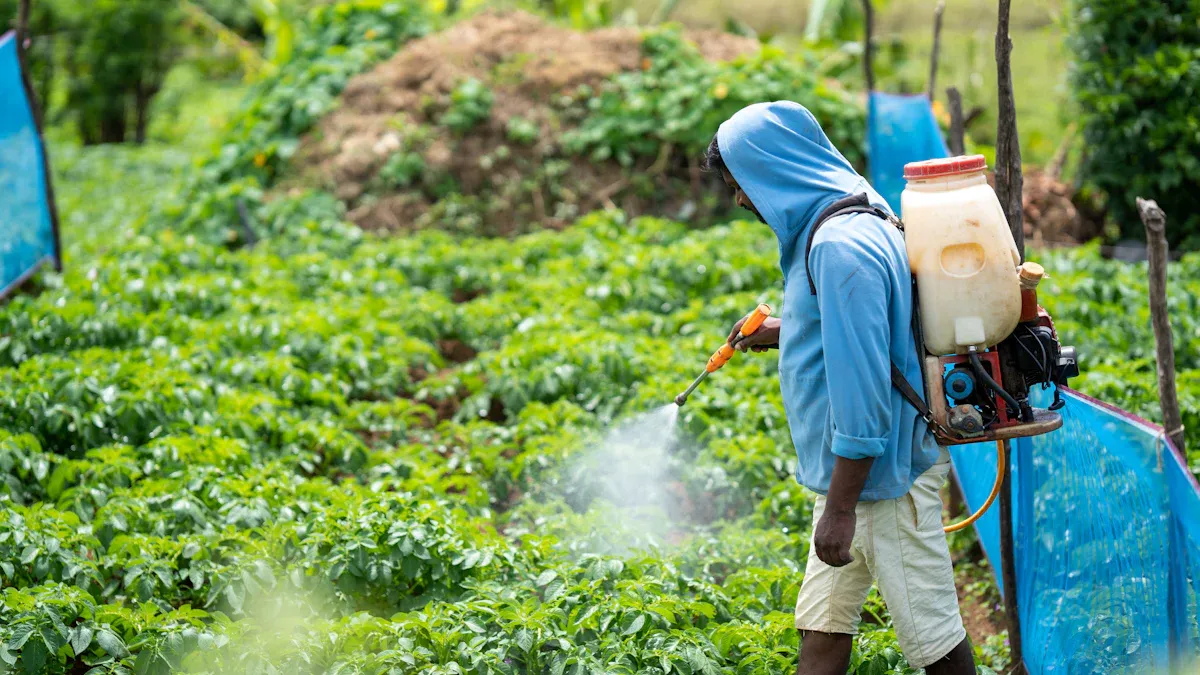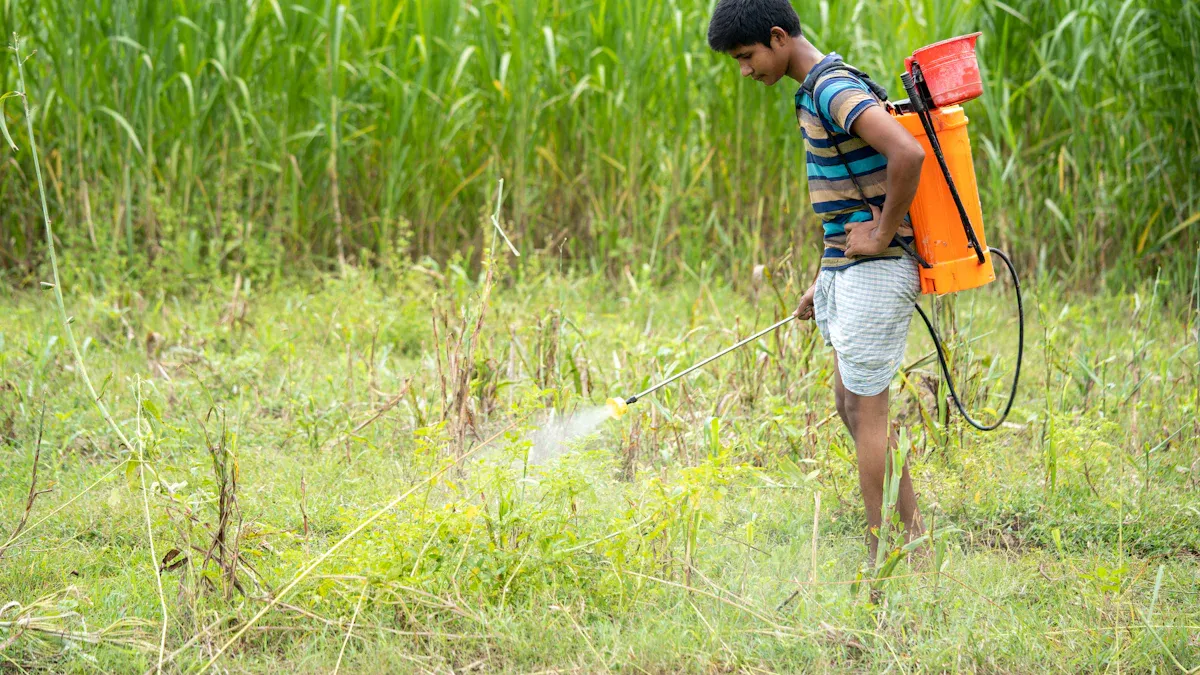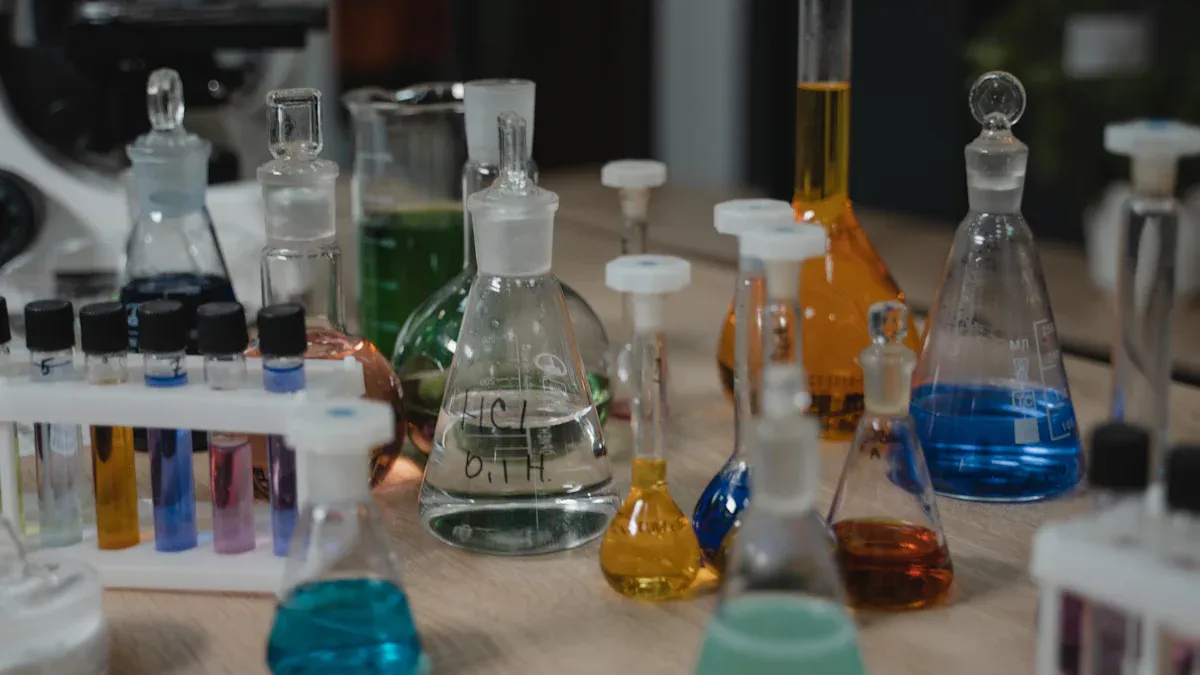
When protecting crops, emamectin benzoate is a trusted choice. This pesticide affects pests' nervous systems, keeping plants safe. It is trusted worldwide for being effective and safe.
In 2023, emamectin benzoate's global market was worth $210 million.
Experts predict it will reach $380 million by 2033, growing 6.1% yearly.
Research shows new nano-formulations of emamectin benzoate are less toxic. They also have shorter waiting times before harvest, making them safer for people and nature.
Key Takeaways
Emamectin benzoate is a safe bug killer. It protects crops from harmful bugs but does not harm helpful insects like bees.
This bug killer works well in small amounts. It reduces the need to spray often, saving farmers time and money.
Using emamectin benzoate keeps the environment healthy. It only targets bad bugs and supports eco-friendly farming.
Farmers can use emamectin benzoate on many crops, like fruits and vegetables. This makes it a useful choice for pest control.
To work best, apply it correctly and at the right time. Always follow the instructions and spray when bugs are easiest to kill.
What Is Emamectin Benzoate?
Definition and Composition
Emamectin benzoate is a chemical used to protect crops. It comes from natural soil bacteria called Streptomyces avermitilis. This makes it a partly natural pesticide that targets pests but keeps crops safe.
It comes in forms like water-soluble granules and liquid concentrates. These forms make it simple to use on crops. Its active ingredient works well even in small amounts, giving strong protection without using too much.
Did You Know?
Emamectin benzoate is often mixed with other ingredients. This helps it stay effective in different weather conditions.
Role as an Insecticide
Emamectin benzoate is important for controlling pests. It affects pests like caterpillars, borers, and leaf miners. When pests eat treated plants, it stops their nerve signals. This causes them to become paralyzed and die, keeping crops safe.
One special feature is its ability to move through leaves. It protects both the top and bottom of leaves. This means pests hiding under leaves are also controlled. It also lasts a long time, so you don’t need to spray often.
Using emamectin benzoate helps control pests while protecting helpful insects like bees. This makes it a good choice for eco-friendly farming.
How Emamectin Benzoate Works
How It Affects Pests
Emamectin benzoate attacks pests' nervous systems to stop infestations. When pests eat treated plants, it affects their nerve cells. It blocks chloride channels, causing their nerves to overreact. This leads to shaking, loss of movement, and paralysis. Eventually, the pests die.
This chemical works in two ways on chloride channels. One part opens the channel, and another part blocks it. This double action makes it strong even in small amounts. For example, studies show it works at just 0.1 mg/kg/day.
Evidence Type | Details |
|---|---|
Target Organ | It mainly targets the nervous system of pests. |
Clinical Signs | Pests show shaking, poor movement, and a hunched body. |
Neuropathology | Nerve and muscle damage are seen in affected pests. |
Dose/Response | Small doses cause strong effects, showing its power. |
Sensitivity | Some animals, like CF-1 mice, are more sensitive due to their genes. |
This action makes emamectin benzoate great for pest control. It kills harmful pests like caterpillars but spares helpful insects like bees. This helps farmers grow crops in an eco-friendly way.
Movement Through Leaves and Long-Lasting Effects
Emamectin benzoate moves through leaves after being sprayed. It spreads inside the plant, protecting both sides of the leaves. Even pests hiding under leaves are exposed to the chemical.
It also stays active for a long time after spraying. This means farmers don’t need to spray often, saving time and money. Fewer sprays also reduce harm to the environment.
Studies show emamectin benzoate works better when combined with other methods. For example, mixing it with nucleopolyhedrovirus (NPV) kills more pests like Spodoptera litura. This mix also helps fight pest resistance, making it a useful choice for farmers.
Study Focus | Results |
|---|---|
Emamectin Benzoate vs. NPV | Combining them kills more pests and stops them from growing. |
Effectiveness against S. litura | Helps solve pest resistance problems. |
Larval Mortality | More pests die when both are used together. |
Comparison with Synthetic Insecticides | Safer for other animals and less harmful to humans. |
With its ability to move through leaves and last long, emamectin benzoate protects crops well. It helps farmers grow healthy plants and get better harvests. This makes it an important tool in farming today.
Benefits of Emamectin Benzoate for Crop Protection


Types of Pests Controlled
Emamectin benzoate works well against many harmful pests. It targets insects like caterpillars, borers, and leaf miners. These pests can damage plants badly if not controlled. By stopping their movement, it keeps your crops safe.
Tests show emamectin benzoate is better than other insecticides. Compared to leufenuron and thiamethoxam, it needs less to work. Its low LC50 value proves it is very effective. This makes it a great choice for pest control plans. It also reduces the need for frequent spraying, saving time and money.
This pesticide is also gentle on helpful insects like pollinators. Pollinators are important for growing crops. By protecting them, emamectin benzoate supports eco-friendly farming. It balances pest control with environmental care.
Compatibility with Various Crops
Emamectin benzoate works with many types of crops. Farmers can use it on vegetables, fruits, and more. It also works well with natural pest control methods. Research shows it is safe to use with biological agents.
Crop Type | Biological Control Agents | Compatibility Results |
|---|---|---|
Vegetables | Amblyseius swirskii, Orius laevigatus | Safe if used 3 days before introducing insects; harmful if sprayed directly. |
Vegetables | Macrolophus pygmaeus, Chrysoperla carnea | Insects survived direct sprays; safe to use together. |
Brinjal, Okra | Neem Baan® | No harm to plants; helped increase crop yields. |
For example, using it three days before adding Amblyseius swirskii keeps insects safe. It also does not harm crops like brinjal and okra. This ensures healthy plants and better harvests. Its flexibility helps farmers protect crops without harming nature.
Safety Aspects of Emamectin Benzoate
Human and Animal Safety
Emamectin benzoate is safe when used properly. It has low toxicity for people and animals, making it a trusted option. Studies confirm it does not cause cancer or genetic problems. Experts classify it as "unlikely to cause cancer in humans," giving you peace of mind.
The EPA says emamectin benzoate is safe for everyone, including kids. This is based on detailed safety checks and exposure studies. You can trust that this pesticide has been carefully tested to ensure it is safe to use.
Special tools like HPLC/FLD check residue levels on crops. These tools make sure food stays safe and free from harmful amounts. This protects consumers and keeps food healthy.
Environmental Impact
Emamectin benzoate is made to protect the environment. It is safe for plants, fish, and water life. The EPA confirms it does not harm these important parts of nature.
Unlike other pesticides, it only targets pests and spares helpful insects. Bees and other good bugs stay safe, helping your crops and the environment. This makes it a great choice for eco-friendly farming.
Groups like the NCC agree with the EPA’s findings. They highlight its low risk to people and its support for green farming. By using emamectin benzoate, you help protect nature while controlling pests.
Regulatory Approvals
Emamectin benzoate is approved by agencies worldwide. These approvals show it is safe and works well. Below is a summary of key findings:
Evidence Type | Description |
|---|---|
Cancer and Genetic Risk Studies | Classified as "unlikely to cause cancer in humans." |
Safety Conclusion | EPA says it is safe with no harm from normal use. |
Testing Methods | HPLC/FLD ensures crop residue levels are within safe limits. |
These approvals prove emamectin benzoate meets strict safety rules. You can trust it to protect crops while keeping people and the environment safe.
Best Practices for Using Emamectin Benzoate
Application Methods
To use emamectin benzoate well, apply it the right way. Spray it evenly on crops for the best results. Use a sprayer that makes small droplets to cover plants better. Focus on spots where pests hide, like under leaves.
For big farms, mechanical sprayers or drones work fast and cover more ground. On small farms, handheld sprayers are just as good. Always clean your tools before and after spraying to keep them safe.
Tip: Spray emamectin benzoate when the weather is calm. Wind can blow it away and make it less effective.
Dosage and Timing
Using the correct amount of emamectin benzoate is very important. Read the label and follow the dosage instructions carefully. Too much can hurt crops, and too little won’t stop pests.
Timing also matters. Spray when pests are young, like in the larva stage. This works better and helps stop pests from becoming resistant. Morning or late afternoon is the best time to spray because it’s cooler, and the pesticide lasts longer.
Crop Type | Recommended Dosage (per hectare) | Best Time to Apply |
|---|---|---|
Vegetables | 100-200 grams | Early morning or evening |
Fruits | 150-250 grams | When pests are most active |
Precautions for Safe Use
Always stay safe when using pesticides. Wear gloves, goggles, and a mask to protect yourself. Keep kids and animals away until the sprayed area is dry.
Store emamectin benzoate in a cool, dry place, far from food and water. Throw away empty containers properly to avoid harming the environment.
Note: Don’t mix emamectin benzoate with other chemicals unless the label says it’s okay. Mixing can cause bad reactions or make it less effective.
By following these steps, you can use emamectin benzoate safely. It will protect your crops, keep you safe, and help the environment.
Emamectin benzoate is a safe way to protect crops. It kills harmful pests but does not harm helpful insects. This makes it great for eco-friendly farming. Use it correctly to get the best results and healthy crops.
Key Takeaway: Using emamectin benzoate carefully protects crops and helps nature. Add it to your pest control plan for better harvests and a cleaner environment.
FAQ
What crops can emamectin benzoate be used on?
Emamectin benzoate works on many crops like vegetables, fruits, and grains. It is effective for tomatoes, okra, brinjal, and apples. Always read the label for crop-specific instructions.
Is emamectin benzoate safe for bees?
Yes, emamectin benzoate is safe for bees if used properly. It kills harmful pests but spares helpful insects. To protect bees, avoid spraying when they are active and follow usage directions.
Tip: Spray early morning or evening to keep pollinators safe.
How often should emamectin benzoate be applied?
Apply emamectin benzoate based on pest levels and crop needs. One spray lasts weeks because it stays effective for a long time. Don’t overuse it to avoid harming the environment or causing pest resistance.
Can emamectin benzoate harm people or animals?
If used correctly, emamectin benzoate is safe for people and animals. It has low toxicity and is tested for safety. Always wear gloves and masks while spraying. Keep it away from food and water.


